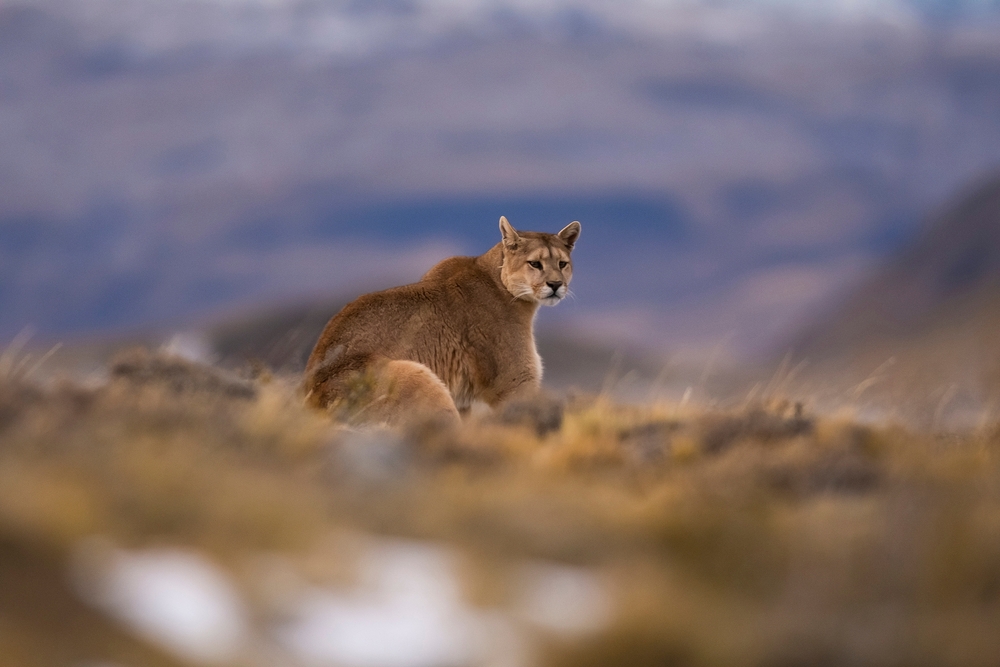Puma sighting in Chile: everything you must know for a wild expedition
By: Hernan Claro - 14 November, 2024

If you are a lover of fantastic animals and incredible landscapes, then going after the puma tracks at the Torres del Paine National Park can be the dream scenario for you- For that reason, by reading this you can learn everything you must know to live the experience without disturbing or putting at risk the local fauna.
Torres del Paine National Park

This spectacular scenario is also the home of many pumas in Chile. @marcobottigelli
The Torres del Paine represent one of the most spectacular landscapes on earth, adding to that the Grey glacier, the British and French lookout or the Pehoé lake in the same park, then you know you’re in a place full of natural wonders. This is not only the home of amazing mountains, glaciers and lakes, it’s also one of the best places to find impressive pumas.
The geography in the park, apt for these felines to find shelter in its caves, hills and scrub, is one of the main reasons why they can be seen around the area. Moreover, you can find a considerable amount of guanacos that serve as food for pumas. Because of this, an experienced tracker, dedicated to knowing their methods and the places they go around, has great opportunities to find one.
If you want to have this experience, we recommend you hire tourism services registered with Sernatur. You can check this information here.
The puma’s charm

The sharp and fancy features of the feline. @dani.paz
There are many reasons why the Puma attracts curious people from all over the world. One of the main ones is the difficulty to find one because it is an animal that usually remains hidden. It prefers to stay away from humans, which makes looking for it an interesting and complex task. Besides this, despite being an animal that means no harm towards humans, knowing that it is capable enough to defend itself gives it a different mystique in comparison with other animals sighting.
From a photographic perspective, pumas are a type of animal that at the same time is fierce and elegant. Its capacity to hunt other animals along with its feline features make it bring together a series of factors that is particular to the animal kingdom. Apart from this, its coats, eyes and silhouettes have great beauty to capture with the photographic lens.
What should I do if a run into a puma

A puma searching for prey at dusk in Torres del Paine. @fabian.brioness
In general terms, pumas don’t let themselves be seen during daytime, so they are usually hidden resting. Even so, capturing them at night can be a great technical challenge. That’s why the best time to get a picture of this feline is at dusk, with sunset. It’s also good to keep in mind that the best time to visit Torres del Paine Park is between October and April.
Keeping in mind all the above-mentioned, it’s key to remember that there have been dangerous encounters with pumas, that this activity is NOT exempt of danger and that it must be done with experimented and correctly certified guides and equipment.
In case of a possible puma attack, these are the CONAF recommendations:
- Stay calm and don’t run.
- Remain firm and face the animal, keeping eye contact.
- Carry children so they don’t run away.
- Never turn your back on the puma and walk backwards slowly while maintaining eye contact.
- Try to look bigger, lifting your arms, keep yourself straight and in vertical position.
- Don’t sit or crouch.
- Don’t climb a tree or rock. The puma can do it better than you.
- Don’t go near the animal, especially if it’s feeding or with its pups.
- Most pumas will avoid confrontation. Don’t’ corner it and provide an escape route.
- If you’re traveling by vehicle and you run into a puma. Don’t get out of the vehicle to follow it.
Take care of nature

Such a magical place must be protected. @marcobottigelli
In addition to your own safety considerations, you must keep in mind the natural flow of life in the park to protect its flora and fauna. To make sure, always follow the following rules in a national park:
- Drive carefully, moderate speed and extreme attention to prevent accidents and disturbance of the flora and fauna.
- Entry of pets is forbidden into protected wildlife areas.
- Avoid making disturbing noises.
- Don’t feed the native fauna.
- Take all your trash out of the protected wildlife areas.
- Don’t remove nor damage the archaeological, paleontological or historical remains.

















